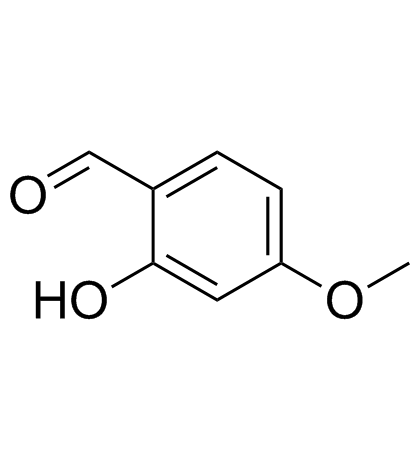2-羟基-4-甲氧基苯甲醛

2-羟基-4-甲氧基苯甲醛结构式

|
常用名 | 2-羟基-4-甲氧基苯甲醛 | 英文名 | 2-Hydroxy-4-methoxybenzaldehyde |
|---|---|---|---|---|
| CAS号 | 673-22-3 | 分子量 | 152.15 | |
| 密度 | 1.2±0.1 g/cm3 | 沸点 | 271.5±20.0 °C at 760 mmHg | |
| 分子式 | C8H8O3 | 熔点 | 41-43 °C(lit.) | |
| MSDS | 中文版 美版 | 闪点 | 112.1±15.3 °C | |
| 符号 |

GHS07 |
信号词 | Warning |
|
3D-QSAR and molecular docking studies of benzaldehyde thiosemicarbazone, benzaldehyde, benzoic acid, and their derivatives as phenoloxidase inhibitors.
Bioorg. Med. Chem. 15 , 2006-15, (2007) Phenoloxidase (PO), also known as tyrosinase, is a key enzyme in insect development, responsible for catalyzing the hydroxylation of tyrosine into o-diphenols and the oxidation of o-diphenols into o-quinones. Inhibition of PO may provide a basis for novel env... |
|
|
Flavoring extracts of Hemidesmus indicus roots and Vanilla planifolia pods exhibit in vitro acetylcholinesterase inhibitory activities.
Plant Foods Hum. Nutr. 68(3) , 247-53, (2013) Acetylcholinesterase inhibitors (AChEIs) are important for treatment of Alzheimer's disease and other neurological disorders. Search for potent and safe AChEIs from plant sources still continues. In the present work, we explored fragrant plant extracts that a... |
|
|
Inhibition of Cancer Cell Proliferation and Antiradical Effects of Decoction, Hydroalcoholic Extract, and Principal Constituents of Hemidesmus indicus R. Br.
Phytother Res. 29 , 857-63, (2015) Indian Sarsaparilla (Hemidesmus indicus R. Br.) is widely used in Indian traditional medicine. In the present work, we explored the effects of decoction, traditional Ayurvedic preparation, and hydroalcoholic extract, a phytocomplex more traditionally studied ... |
|
|
Shikimate pathway modulates the elicitor-stimulated accumulation of fragrant 2-hydroxy-4-methoxybenzaldehyde in Hemidesmus indicus roots.
Plant Physiol. Biochem. 56 , 104-8, (2012) Enzymatic route to fragrant 2-hydroxy-4-methoxybenzaldehyde (MBALD) formation in Hemidesmus indicus roots is not known. Earlier studies with H. indicus excised roots suggested a possible origin of MBALD via central phenylpropanoid pathway. Different elicitors... |
|
|
2-Hydroxy-4-methoxybenzaldehyde: a potent tyrosinase inhibitor from African medicinal plants.
Planta Med. 65(1) , 19-22, (1999) By bioassay-guided fractionation using mushroom tyrosinase (EC 1.14.18.1), 2-hydroxy-4-methoxybenzaldehyde was characterized as the principal tyrosinase inhibitor from three East African medicinal plants, the root of Mondia whitei (Hook) Skeels (Asclepiaceae)... |
|
|
Antimicrobial and antioxidant activities of the root bark essential oil of Periploca sepium and its main component 2-hydroxy-4-methoxybenzaldehyde.
Molecules 15(8) , 5807-17, (2010) The root bark essential oil of Periploca sepium Bunge (Asclepiadaceae/ Apocynaceae) obtained by hydrodistillation was investigated by GC and GC-MS. 2-Hydroxy-4-methoxybenzaldehyde was found to be the main component (78.8% of the total) among 17 identified com... |
|
|
Antioxidant property of Decalepis hamiltonii Wight & Arn.
Indian J. Exp. Biol. 44(10) , 832-7, (2006) Aromatic edible root of D. hamiltonii was subjected to the extraction of the antioxidant rich fraction. Different parts of root namely whole tuber, peel, tuber without peel and medullary portion were extracted with dichloromethane (European Patent No. W020050... |
|
|
Production of 2-hydroxy-4-methoxybenzaldehyde in roots of tissue culture raised and acclimatized plants of Decalepis hamiltonii Wight & Arn., an endangered shrub endemic to Southern India and evaluation of its performance vis-a-vis plants from natural habitat.
Indian J. Exp. Biol. 42(1) , 106-10, (2004) Axillary buds obtained from field grown plants of D. hamiltonii were used to initiate multiple shoots on Murashige and Skoog's medium (MS) supplemented with 2 mg L(-1) 6-benzyl aminopurine (BA) and 0.5 mg L(-1) indole-3-acetic acid (IAA). Profuse rooting was ... |
|
|
Antiangiogenic versus cytotoxic activity in analogues of aeroplysinin-1.
Bioorg. Med. Chem. 15 , 5300-15, (2007) A series of analogues of the potentially angiogenic inhibitor aeroplysinin-1 1 were synthesized and their in vitro antiangiogenic and cytotoxic activities evaluated. In the case of epoxy ketone 6 and azlactone 36 the relationship sprouting inhibition assay/cy... |
|
|
2-hydroxy-4-isopropylbenzaldehyde, a potent partial tyrosinase inhibitor.
Bioorg. Med. Chem. Lett. 14(3) , 681-3, (2004) Chamaecin (2-hydroxy-4-isopropylbenzaldehyde) was synthesized and tested for its tyrosinase inhibitory activity. It partially inhibits the oxidation of L-3,4-dihydroxyphenylalanine (L-DOPA) catalyzed by mushroom tyrosinase with an IC(50) of 2.3 microM. The in... |